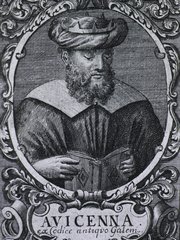This article is part of the series "A Moment in History" where we honor those who have contributed to the growth of medical knowledge in the areas of anatomy, medicine, surgery, and medical research.

Avicenna
Avicenna (980 AD – 1037 AD) Persian physician, philosopher, mathematician, naturalist, geologist, musical theorist, astronomer and poet. Ab? Al? al-Hysayn ibn-‘Abd-All?h ibn-S?na, also known as “ibn-S?na“ and as “Avicenna” was born in Afshaneh, near the city of Bokhara (in old Persia, what today is Iran) in 980AD.
Intellectually gifted, Avicenna studied philosophy and the Islam religion, with early studies in medicine. By age 18 he was already a famous physician. With access to the royal library Avicenna continued his studies and traveled through what today is Iran. Avicenna had government positions, becoming prime minister. Jailed for political reasons Avicenna wrote a large number of his medical, philosophical, and astronomical publications while in jail.
Of over 450 total medical books attributed to Avicenna, his most famous publication was the “al-Qanun-fi-al-Tibb” or the “Canon of Medicine”, consisting of five books on principles of medicine, diseases, drugs, and compound medicines. The Canon was translated into Latin and later into other languages, remaining an important book for at least until the 16th century.
He used the term “vermis” and spoke of the “tailed nucleus”, known to us as the “caudate nucleus”. Avicenna died in 1037AD at 57 years of age. He was buried in the city of Hamadh?n, where his tomb still exists. Avicenna has been called the “prince of physicians”.
Sources
1. “Avicenna” Koontz AR JAMA. 1962;179(1):99
2. "Honoring Avicenna, the Great Persian Physician on the World's Postage Stamps". Afshar, A. Arch Iranian Med (1029-2977), 13 (5), 447
3. "Avicenna and the Canon of Medicine: A millennial tribute" West J Med 133:367-370, Oct 1980
4. “Avicenna (980–1037 AD) Zargaran, A, et al. J Neurol (2012) 259:389–390 5. “Avicenna” JAMA 177:704 (1961)
Original image courtesy of NLM



